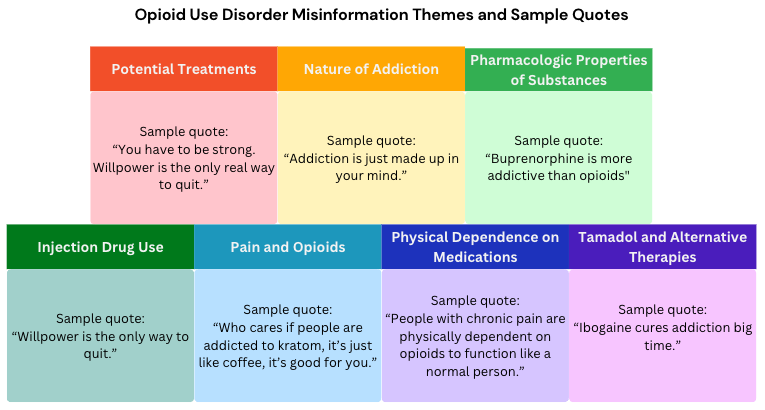Over 2.7 million Americans aged 12 years and older meet the diagnostic criteria for opioid use disorder (OUD). The Internet is one of the primary ways in which people seek health information. Unfortunately, the Internet contains a large amount of false or inaccurate information. For people with OUD, reading misinformation about their condition could mean the difference between receiving life saving treatment or overdosing. Because of this, it is important to understand what types of misinformation are present online so that the public can be inoculated against these myths and make better informed decisions about their own health. This week, STASH reviews a study by Mai ElSherief and colleagues that explored what new types of misinformation about OUD were appearing on a variety of social media platforms.
What was the research question?
What new types of misinformation about opioid use disorder treatment are being shared and discussed on social media platforms?
What did the researchers do?
The researchers first searched for opioid- related keywords (e.g., the names of natural opiates, semisynthetic opioids, and synthetic opioids) within posts that appeared between January 1, 2018, and December 31, 2019 on X (formerly known as Twitter), YouTube, and other health communities such as Reddit and Drugs-Forum.com. This resulted in a total of 1,189,590 posts, and 12,293,829 comments. The researchers identified posts that contained language that was semantically similar to the language used in three common myths about OUD: that (1) engaging in agonist or drug-assisted therapies would mean trading one addiction for another; (2) “only patients treated with opioids who have certain characteristics are at higher risk for opioid addiction”; and (3) the drug tramadol, a strong painkiller, is a nonaddictive opioid alternative. This effectively reduced their sample to 800 posts. Next, the researchers had a set of three health experts individually review the 800 posts and state whether the posts were related to any one of the three “seed” myths, were related to a new myth, or neither. This process identified 303 posts that discussed new myths that were independent from the three seed myths. After this, the researchers used a clustering technique to group the 303 posts by semantic similarity. The public health experts then reviewed the groups and named them.
What did they find?
In total, the researchers identified seven clusters or themes that represent new types of misinformation related to opioid use disorder. These were (in order of prevalence): potential OUD treatments (present in 29.8% of the 303 posts), the nature of addiction (22.5%) pharmacologic properties of substances (16.9%), injection drug use (11.9%), pain and opioids ( 9.3%), physical dependence of medications (7.2%), and tramadol use (2.3%). See Figure for a representation of these themes.

Figure. This Figure, adapted from Mai ElSherief and colleagues depicts the most common types of misinformation related to opioid use disorder on different social media platforms and provides representative quotes for each theme. Click to enlarge.
Why do these findings matter?
These findings are important because the researchers developed a systematic method for identifying OUD misinformation on social media. Other researchers could replicate these findings in other domains to systematically identify the most common myths or misconceptions related to any topic. Then, using the results of said findings, social media companies would be able to systematically identify and flag posts that contained any form of misinformation that had the potential to worsen health outcomes.
Every study has limitations. What are the limitations in this study?
This study was subject to several limitations. Notably, the nature of myths and misinformation is transient. That is, if something is considered to be misinformation at one point in time, it might be factual at a later point in time. The opposite is also true in that factual information could later be deemed as misinformation as new information comes to light. With this being said, the seven most common types of misinformation related to OUD in this study might not always represent the most common forms of misinformation that are circulating on social media. Because of this, it would be important to periodically replicate and update the results of the study to accurately reflect the current state of OUD misinformation. Another limitation is that the researchers used a limited pool of health experts to assess OUD myths and misinformation. Because of this, there could be gaps in how the study classified or identified OUD misinformation.
For more information:
If you are worried that you or someone you know is experiencing addiction, the SAMHSA National Helpline is a free treatment and information service available 24/7. For more details about addiction, visit our Addiction Resources page.
— Seth McCullock, PhD




